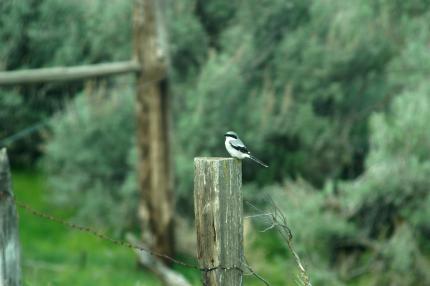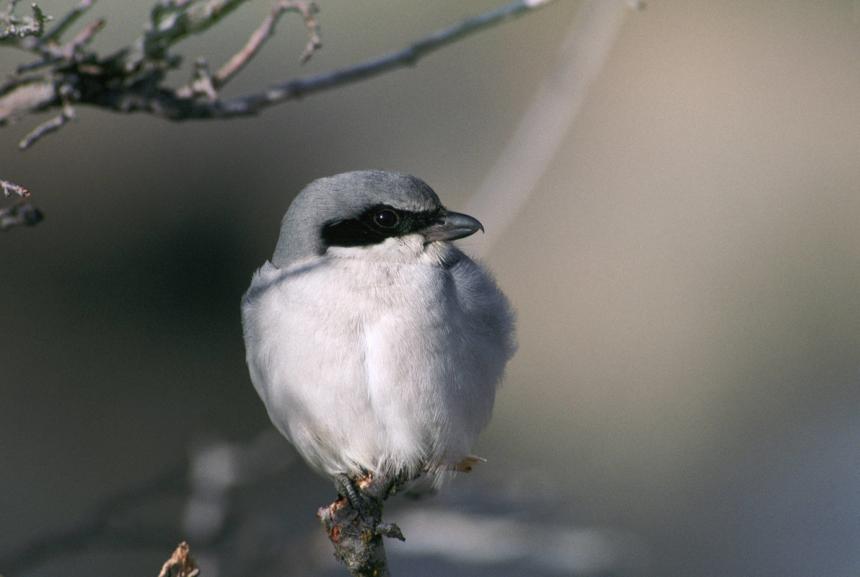Low-
Moderate
The population size of loggerhead shrike in Washington is low. This species is strongly associated with shrubsteppe in Washington and has likely experienced a population decline in accordance with loss and conversion of shrubsteppe habitat.
Description and Range
Physical description
An adult loggerhead shrike is about 8 to 9 inches in length. It has a gray head and back, a black mask that extends over the upper bill, and a white throat and underside. The head is large, and the bill is thick and hooked. The tail is long, and black wings sport a white patch.
Ecology and life history
Most loggerhead shrikes arrive in Washington mid- to late March and depart on fall migration by September.

Shrikes hunt from high perches and fly swiftly down upon their prey. Sometimes called "butcherbirds", these shrikes are the only “passerines” (perching birds) capable of killing “vertebrates” (animals with a backbone) by biting the neck and detaching the bones. Shrikes may impale their prey on thorns or barbed wire to be eaten later. Impaling prey is a strategy that shrikes use since they lack large feet and talons like “raptors” (birds of prey).
Loggerhead shrikes are generalists, feeding on any animal they can subdue, including insects, small mammals, birds, reptiles, and amphibians. During the breeding season in Washington, shrikes largely feed on insects.
The shrikes breed in open country, including shrubsteppe and grasslands where there are scattered tall shrubs, fence posts, utility wires, or other lookout posts. They generally nest in dense, thorny trees, or shrubs. Predation is a frequent cause of nest failure, particularly by gopher snakes, black-billed magpies, common ravens, and coyotes.
Geographic range
The species is found in portions of Alberta and Saskatchewan, and throughout much of the U.S. south to southern Mexico. Northern populations are migratory, wintering across the southern U. S. and Mexico.
This species is a local summer resident in eastern Washington, but it is rare there during winter. There are no population estimates for the species in Washington. The size of the state’s breeding population is unknown. The loggerhead shrike was probably much more abundant in Washington prior to the widespread conversion of shrubsteppe to cropland.
For a map of range-wide distribution and conservation status of this species, check out NatureServe Explorer.
Climate vulnerability
Sensitivity to climate change
Low
Loggerhead shrikes likely exhibit low physiological sensitivity to climate change, although very little information currently exists on this topic. They are more sensitive to changes in prey abundance, habitat availability, and competition as a result of climate change. Loggerhead shrikes prey on insects, reptiles, and small mammals and birds; insect prey, in particular, may vary in availability in response to temperature and drought. Loggerhead shrikes favor open habitats with low-stature vegetation and available trees and shrubs for nesting; prairie/grassland habitats may expand with climate change, benefitting this species. They also successfully inhabit many altered systems (e.g., agricultural fields). Wind, drought, and/or cold/wet weather events may contribute to nest or brood loss from nest damage or shifts in prey availability.
Exposure to climate change
Low-
Moderate
- Increased temperatures
- Drought
- Increased storminess and/or high wind events
Conservation
Conservation Threats and Actions Needed
- Fish and wildlife habitat loss or degradation
- Threat: Conversion of shrubsteppe habitat; most of impact has already occurred; amount of continuing impact uncertain.
- Action Needed: Restoration of degraded or lost habitat; protection of existing habitat. Protect nest sites from disturbance.
- Threat: Loss of sagebrush from wildfire.
- Action Needed: Reduce wildfire risk and prevent establishment of exotic plant species after fires.
- Resource information needs
- Threat: Unknown if Breeding Bird Surveys results reflect actual Washington population trend.
- Action Needed: Conduct comprehensive surveys.
See the Climate vulnerability section for information about the threats posed by climate change to this species.
Resources
References
Wahl, T. R. 2005. Loggerhead Shrike (Lanius ludovicianus). Pp 254-255 in T. R. Wahl, B. Tweit, and S. G. Mlodinow (eds.) Birds of Washington: Status and Distribution. Oregon State University Press, Corvallis, OR, USA. 436 pp.
Yosef, R. 1996. Loggerhead Shrike (Lanius ludovicianus). The Birds of North America 231:1-28.


